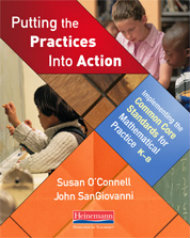Putting the Practices into Action: Implementing the CCSS for Math
Putting the Practices into Action: Implementing the Common Core Standards for Mathematical Practice K-8
By Susan O’Connell and John SanGiovanni
(Heinemann, 2013 – Learn more)
I have to admit, when the Common Core State Standards for Mathematics were introduced, I was a bit overwhelmed. I heard through the grapevine that the new standards were more rigorous than prior mathematics standards, and I wondered if and when professional development would be given.
Since answering open-ended questions is one of the areas that many students find difficult, all I could think of was how I’d be able to teach my students how to incorporate basic math skills as we pursued the new standards for math practice. Putting the Practices into Action: Implementing the Common Core Standards for Mathematical Practice K-8 by Susan O’Connell and John SanGiovanni helped to ease my fears.

How we teach must reflect how our students learn and also reflect current best teaching practices. Our teaching must also anticipate the world our students will move into as adults — rapidly changing, connected, adapting and evolving.
What’s in the book
Each chapter of Putting the Practices into Action identifies a mathematical standard that is modeled with examples and opportunities to apply the strategies, identification of opportunities for differentiation and collaboration, assessment tips, and additional ideas for developing the practice.
The authors do an excellent job in breaking each standard down to address:
- why the standard is important
- how to interpret and understand the standard
- how to apply the standard in your current teaching practices
As I read each page, I was astounded by the “gifts” the authors presented. It’s a rare professional book (I read a lot of them!) that provides “connections to other practice standards,” rubrics, student dialogue and examples, additional ideas for developing the practice, and a summary at the end of every chapter.
Writing this book must have been a difficult task. How do you author a book that meets all grade level expectations from kindergarten to eighth grade? And yet, they have succeeded. As I read the book, I felt as if the authors honored not just the language of the standards, but provided valid examples from all grade levels so teachers would be able to enact the mathematical practice in their own classrooms.
And the examples are from real classrooms, with annotations that show possible areas of misunderstanding or confusion. For example, in chapter 4, Exploring Standard 3: Construct Viable Arguments and Critique the Reasoning of Others, the authors offer examples where students are required to develop arguments which will justify their thinking. Students are asked to turn and talk with their peers and defend their arguments with evidence to support their answers. By focusing on mathematical process skills, teachers empower students to think creatively and critically about mathematics.
Interacting with the book
When I started to read Putting the Practices into Action, I sat with a highlighter and sticky notes in hand, but I quickly realized that I was running out of stickies and ink in my highlighter. I decided the best way to gather this valuable information was to use the “old fashioned” method of organizing the mathematical concepts with color coded note cards for each area (geometry, numerical analysis, data, and open ended questions) and linking them together with book rings.
What also impressed me was the passion Susan O’Connell and John SanGiovanni exhibited throughout the book. They truly want teachers to understand the new standards in such a way that we do not feel intimidated or abandoned. They create a feeling of “we can do this together.”
This is not a book that you read once and then put away. It is not a coffee table or desk book to display. This book is guaranteed to NOT gather dust on the shelf but to become dog-eared, highlighted, filled with Post Its, and referred to consistently. It is a book that will be the focus of many professional learning groups because it a classic and models effective best teaching practices in mathematics.
Linda Biondi is a fourth grade teacher at Pond Road Middle School in Robbinsville, NJ, and a recipient of several educational grants that infuse a literacy enriched curriculum, along with an understanding of individual learning styles to help students understand bias and patterns of discrimination. She is a Teacher Consultant with the National Writing Project and a participant on the NJ Department of Education Teacher Advisory Panel.




































